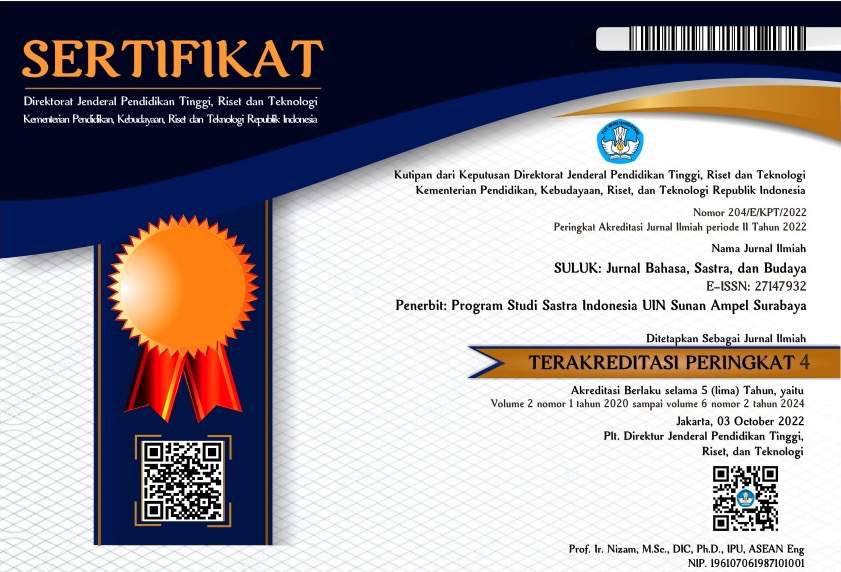The Social Messages in The Ramayana: Perspektif on Literary Theory
DOI:
https://doi.org/10.15642/suluk.2019.1.1.11-18Keywords:
Exemplary, Kakawin Ramayana, Ramayana, Social MessageAbstract
The story of Ramayana has been deeply rooted in the community and is a material for literary studies that has never completed for discussion. In Java the epic, Ramayana first fully appeared in the form of a relief at the Lara Jonggrang Temple which was built around the year 782 to 872.The other emergence about the Ramayana story was in the composition which was in the form ofRamayana kakawin in Old Javanese. The Ramayana story begins with a blessing and a preface including a summary of the story which then contains verses of poetry. This study aims to convey the social messages contained in the Ramayana story to the public. This study uses qualitative research method based on the study of literature in the book of P. Lal (1981) which has been translated into Indonesian. The results of this study are (1) Explaining the social messages contained in the Ramayana story, (2) Explaining the exemplary wisdom of the character Rama, (3) Explaining the exemplary loyalty of the character Sita, (4) Explaining the example of Rahwana's character in the form of perseverance and sincerity in loving Sit, (5) Explaining ibrah (lessons) from the Ramayana story so that it can be used as the life learning. Overall, it can be understood that in the Ramayana there are many social messages that can be used as the exemplary life.
Downloads
References
Amrih, Pitoyo. 2016. Cinta Mati Dasamuka. Yogyakarta: Diva Press.
KBBI daring (online). https://kbbi.web.id/ [23 Mei 2019].
Musthafa, Bachruddin. 2008. Teori dan Praktik Sastra dalam Penelitian dan Pengajaran, Jakarta: Sekolah Pasca Sarjana Universitas Pendidikan Indonesia Bandung dengan New Concept English Education Centre Jakarta.
P. Lal. 1981. The Ramayana of Valmiki (terj). Pustaka Jaya.
Pratikto, Herman. 2011. Hamba Sebut Paduka Ramadewa: Teladan Cinta dan Kehidupan Rama-Sinta. Jakarta: Penerbit Buku Kompas.
Purwanto, Wachid Eko. 2015. “Simbol Rama dalam Epos Ramayana bagi Raja dan Masyarakat Jawa”. https://pbsi.uad.ac.id/wp-content/uploads/SIMBOL-RAMA-JURNAL-BAHASTRA.pdf [8 Mei 2019].
Soeherman, Bonnie. 2017. “Ramayana Walmiki: Eksplorasi Holistik Sistem Pengendalian Manajemen.” https://jamal.ub.ac.id/index.php/jamal/article/view/659/pdf [20Mei 2019].
Utomo, S. Prasetyo. 2017. “Kearifan Lokal Ramayana dalam Budaya Global: Defamiliarisasi Hegemoni Tokoh Novel Kitab Omong Kosong”. PIBSI XXXIX.
Downloads
Published
How to Cite
Issue
Section
License
Copyright (c) 2019 Mirza Fathimajauhar Kamalia, Wildayati Wildayati, Artha Fernando, Iskamar Iskamar, Ismi Imroatus Saada

This work is licensed under a Creative Commons Attribution-ShareAlike 4.0 International License.
- Authors retain copyright and grant the journal right of first publication with the work simultaneously licensed under a Creative Commons Attribution ShareAlike License that allows others to share the work with an acknowledgment of the work's authorship and initial publication in this journal.
- Authors are able to enter into separate, additional contractual arrangements for the non-exclusive distribution of the journal's published version of the work (e.g., post it to an institutional repository or publish it in a book), with an acknowledgment of its initial publication in this journal.
- Authors are permitted and encouraged to post their work online (e.g., in institutional repositories, pre-print sites, or on their website) prior to and during the submission process, as it can lead to productive exchanges, as well as earlier and greater dissemination of published work.








